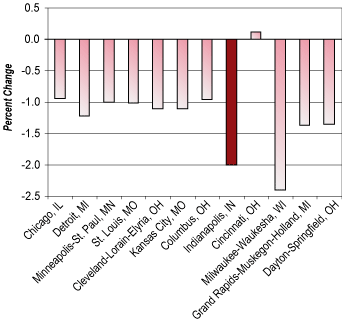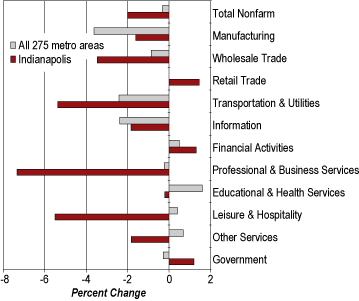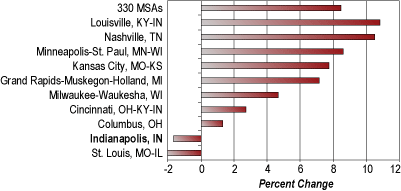Indianapolis
Director Emeritus, Indiana Business Research Center, Kelley School of Business, Indiana University, Bloomington, Indianapolis, and Gary
Hyper-fix, a downtown interstate highway project, was completed with such efficiency that it has been forgotten. The relocation of I-70 alongside the airport is in progress and causing few problems. The U.S. 421 and I-465 interchange was finally completed after a seemingly endless period of time. Even the resurfacing of Binford Boulevard is being undertaken with minimal disruption. These have been the most visible changes in Indianapolis during 2003.
Employment
Less visible was the loss of 17,600 jobs in the nine-county Indianapolis area between September 2002 and the same month this year. This was a 2 percent decline, compared to a national employment drop of just 0.3 percent and a 1.7 percent decline for all eleven Indiana metro areas.
The Indianapolis 2 percent decline ranked 243rd among the nation’s 275 metro areas. Milwaukee ranked 250th, but other competitive areas in the Midwest all surpassed Indianapolis (see Figure 1).
Figure 1
Percent Change in Jobs in Twelve Largest Midwestern Metro Areas, September
2002 to September 2003

Contrary to the popular notion, manufacturing was not the prime cause of job losses in the Indianapolis metro area. As seen in Figure 2, the biggest percentage declines in the metro area were not in manufacturing but in professional and business services, as well as in leisure and hospitality.
Figure 2
Percent Change in Jobs, September 2002 to September 2003

Professional and business services include travel agents, computer systems designers, custom computer programming, advertising, and telemarketing—all activities that have been most adversely affected by the business cycle, major restructuring, or regulatory changes. Manufacturing lost only 1,800 jobs in the past year, while business and professional services lost 7,900 jobs and the leisure and hospitality sector dropped 4,700 jobs.
Building Permits
Residential construction seems to be booming everywhere in the metro area. Yet, despite appearances, it has been down in 2003 from 2002 levels. Of 330 metro areas for which we have building permit data, Indianapolis ranked 225th with a 1.7 percent decline in units authorized. As seen in Figure 3, this does not compare favorably with other metro areas in the U.S. (8.5 percent) or the Midwest.
Figure 3
Change in Residential Units Authorized, Year-to-Date
September 2002 to September 2003

Establishments and Wages
Less recent data also confirm a weaker performance in the Indianapolis metro area than might have been expected. Employer reports from the Department of Workforce Development for the first quarter of 2003 indicate that the Indianapolis metro area added 610 establishments over the course of the year when compared with the same quarter in 2002. This was a prodigious 53 percent of the total increase in establishments for the twelve metro areas of the state (New Albany-Jeffersonville is counted as a metro area for these purposes). But when we look at the total payroll of all establishments in these twelve metro areas, the Indianapolis area contributed only 7 percent to the increase they enjoyed. Average weekly wages in the Indianapolis area rose by a mere 0.6 percent, the lowest increase of all twelve areas.
Prospects for 2004
Despite a lagging economic performance in the past year, Indianapolis may be better positioned for growth in the coming year than other Indiana metro areas. With a diversified employment base, the Hoosier capital stands to gain from major ongoing construction at the airport and an attractive retail environment, which continues to attract shoppers from a wide radius.
Even if the Indianapolis area were to add jobs only at the same rate as the rest of the state (forecast to be a modest 1 percent), the metro area would see a growth of 7,700 jobs. If the state were to grow faster, say 2 percent, there is a good chance that Indianapolis would grow faster than the state and could see 18,000 net new jobs in 2004.
Also in this Issue…
- Outlook for 2004
- The U.S. Economy
- The International Economy
- Financial Forecast
- Corporate Governance and Reporting
- Housing
- Indiana
- Anderson
- Bloomington
- Columbus
- Evansville
- Fort Wayne
- Gary
- Indianapolis
- Kokomo
- Lafayette
- Muncie
- New Albany
- Richmond
- South Bend/Mishawaka and Elkhart/Goshen
- Terre Haute
- Outlook Summary for 2004



